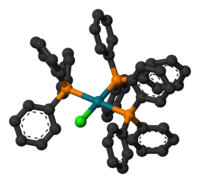
Photo from wikipedia
We previously reported that the tetraazamacrocyclic Schiff base complex [CoIII(CR14)(X)2] n+ (CR14 = 2,12-dimethyl-3,7,11,17-tetraazabicyclo[11.3.1]heptadeca-1(17),2,11,13,15-pentaene, X = Cl ( n = 1) (1-Cl2) or H2O ( n = 3) (1-(H2O)2)) is… Click to show full abstract
We previously reported that the tetraazamacrocyclic Schiff base complex [CoIII(CR14)(X)2] n+ (CR14 = 2,12-dimethyl-3,7,11,17-tetraazabicyclo[11.3.1]heptadeca-1(17),2,11,13,15-pentaene, X = Cl ( n = 1) (1-Cl2) or H2O ( n = 3) (1-(H2O)2)) is a very efficient H2-evolving catalyst (HEC) in fully aqueous solutions at pH 4.0-4.5 when used in a photocatalytic system including a photosensitizer and ascorbate as sacrificial electron donor. The excellent H2-evolving activity of this complex, compared to other cobalt and rhodium catalysts studied in the same photocatalytic conditions, can be related to the high stability of its two-electron reduced form, the putative "Co(I)" state. These very interesting results led us to investigate the H2-evolving performances of a series of compounds from a close-related family, the pentaaza-macrocyclic cobalt [CoII(CR15)(H2O)2]Cl2 complex (2, CR15 = 2,13-dimethyl-3,6,9,12,18-pentaazabicyclo[12.3.1]octadeca-1(18),2,12,14,16-pentaene), which comprises a larger macrocycle with five nitrogen atoms instead of four. Electrochemical as well as spectroscopic investigations in CH3CN coupled to density functional theory (DFT) calculations point to decoordination of one of the amine upon reduction of Co(II) to the low-valent "Co(I)" form. The resulting unchelated amine could potentially act as a proton relay promoting the H2 formation via proton-coupled-electron transfer (PCET) reactions. Besides, the iron, manganese, and zinc analogues, [FeII(CR15)(X)2] n+ (X = Cl ( n = 0) or H2O ( n = 2)) (3), [MnII(CR15)(CH3CN)2](PF6)2 (4), and {[ZnII(CR15)Cl](PF6)} n (5) were also synthesized and investigated. The photocatalytic activity of 2-5 toward proton reduction was then evaluated in a tricomponent system containing the [RuII(bpy)3]Cl2 photosensitizer and ascorbate, in fully aqueous solution. The photocatalytic activity of 2 was also compared with that of 1 in the same experimental conditions. It was found that the number of catalytic cycles versus catalyst for 2 are slightly lower than that for 1, suggesting that if the amine released upon reduction of 2 plays a role in promoting the H2-evolving catalytic activity, other factors balance this effect. Finally, photophysical and nanosecond transient absorption spectroscopies were used to investigate the photocatalytic system.
Journal Title: Inorganic chemistry
Year Published: 2019
Link to full text (if available)
Share on Social Media: Sign Up to like & get
recommendations!